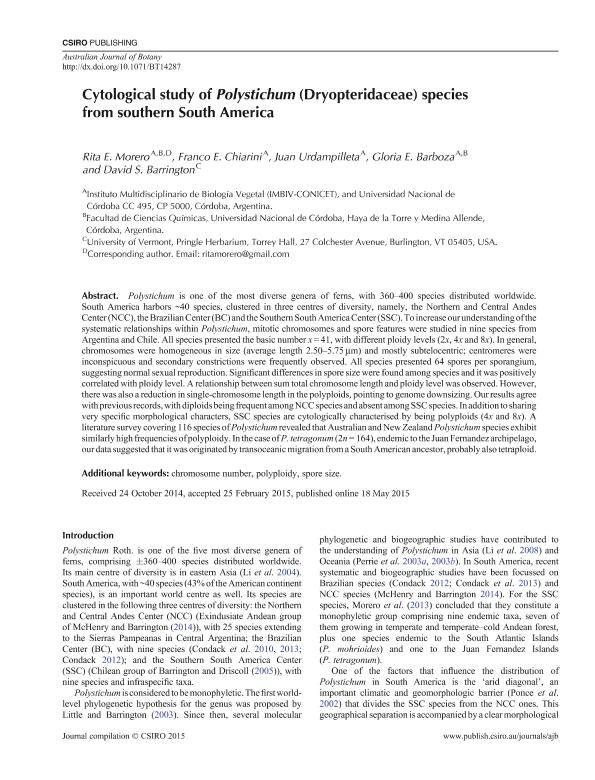Artículo
Cytological study of Polystichum (Dryopteridaceae) species from southern South America
Morero, Rita; Chiarini, Franco Ezequiel ; Urdampilleta, Juan Domingo
; Urdampilleta, Juan Domingo ; Barboza, Gloria Estela
; Barboza, Gloria Estela ; Barrington, D.
; Barrington, D.
 ; Urdampilleta, Juan Domingo
; Urdampilleta, Juan Domingo ; Barboza, Gloria Estela
; Barboza, Gloria Estela ; Barrington, D.
; Barrington, D.
Fecha de publicación:
05/2015
Editorial:
Csiro Publishing
Revista:
Australian Journal Of Botany
ISSN:
0067-1924
Idioma:
Inglés
Tipo de recurso:
Artículo publicado
Clasificación temática:
Resumen
Polystichum is one of the most diverse genera of ferns, with 360–400 species distributed worldwide. South America harbors ~40 species, clustered in three centres of diversity, namely, the Northern and Central Andes Center (NCC), the Brazilian Center (BC) and the Southern South America Center (SSC). To increase our understanding of the systematic relationships within Polystichum, mitotic chromosomes and spore features were studied in nine species from Argentina and Chile. All species presented the basic number x = 41, with different ploidy levels (2x, 4x and 8x). In general, chromosomes were homogeneous in size (average length 2.50–5.75 µm) and mostly subtelocentric; centromeres were inconspicuous and secondary constrictions were frequently observed. All species presented 64 spores per sporangium, suggesting normal sexual reproduction. Significant differences in spore size were found among species and it was positively correlated with ploidy level. A relationship between sum total chromosome length and ploidy level was observed. However, there was also a reduction in single-chromosome length in the polyploids, pointing to genome downsizing. Our results agree with previous records, with diploids being frequent among NCC species and absent among SSC species. In addition to sharing very specific morphological characters, SSC species are cytologically characterised by being polyploids (4x and 8x). A literature survey covering 116 species of Polystichum revealed that Australian and New Zealand Polystichum species exhibit similarly high frequencies of polyploidy. In the case of P. tetragonum (2n = 164), endemic to the Juan Fernandez archipelago, our data suggested that it was originated by transoceanic migration from a South American ancestor, probably also tetraploid.
Palabras clave:
Polystichum
,
Chromosomes
,
Polyploidy
,
Spore Size
Archivos asociados
Licencia
Identificadores
Colecciones
Articulos(IMBIV)
Articulos de INST.MULTIDISCIPL.DE BIOLOGIA VEGETAL (P)
Articulos de INST.MULTIDISCIPL.DE BIOLOGIA VEGETAL (P)
Citación
Morero, Rita; Chiarini, Franco Ezequiel; Urdampilleta, Juan Domingo; Barboza, Gloria Estela; Barrington, D.; Cytological study of Polystichum (Dryopteridaceae) species from southern South America; Csiro Publishing; Australian Journal Of Botany; 63; 5; 5-2015; 403-414
Compartir
Altmétricas



